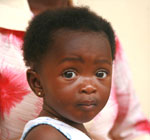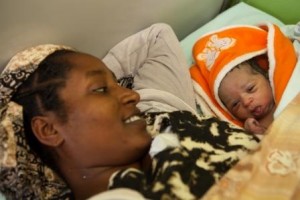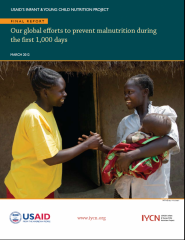 Dear colleagues,
Dear colleagues,
I am pleased to present the Infant & Young Child Nutrition (IYCN) Project’s Final Report: Our global efforts to prevent malnutrition during the first 1,000 days. The report summarizes the IYCN Project’s accomplishments and offers recommendations for building on IYCN’s maternal, infant, and young child nutrition programming that spanned 16 countries over the past five years.
By focusing on prevention of malnutrition during the critical 1,000 days from pregnancy through a child’s second birthday, involving communities in improved nutrition, and strengthening health systems, IYCN aimed to improve the nutritional status of mothers and children and to increase children’s chances of surviving free of HIV. These activities resulted in the following achievements:
- Built an enabling environment for improved nutrition
- Strengthened social and behavior change communication programming
- Enhanced complementary feeding programs
- Increased HIV-free survival for the next generation
- Brought women’s and children’s nutrition to the forefront of agriculture
- Strengthened health systems for healthier mothers and children
Thank you to our global and local partners for your collaboration and support in achieving the accomplishments described in the report. As we mark the final day of the IYCN Project, we hope our experiences and tools continue to assist you in your efforts to reduce the burden of malnutrition and build healthier futures for mothers and children.
Please visit our website to access the report.
Sincerely,
Denise Lionetti
Project Director, IYCN Project
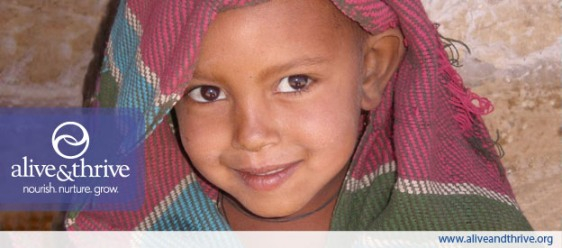
Stay up to date on infant and young child feeding
The Alive & Thrive (A&T) initiative invites you to join our newsletter list. As the year continues, we will be releasing new program and technical reports, mass media, case studies, toolkits, stories, and lessons learned.
Sign up for the A&T newsletter by clicking here.
A&T is an initiative supported by the Bill & Melinda Gates Foundation to improve infant and young child feeding in Bangladesh, Ethiopia, and Viet Nam and to inform policies and programs around the world.
A&T is a consortium of organizations comprising FHI 360, BRAC, GMMB, the International Food Policy Research Institute, Save the Children, the University of California-Davis, and World Vision.
Welcome to the eleventh and final issue of the IYCN Update, a newsletter from USAID’s Infant & Young Child Nutrition (IYCN) Project.
A message from the project director

- The IYCN team, July 2011
Greetings,
The IYCN Project has now completed activities in most of our countries and we will officially close on March 19, 2012. Over the past year, we have been enthusiastically documenting and sharing our experiences from five years of global maternal, infant, and young child nutrition programming. Highlights are included in this newsletter:
- A recently enhanced website, which will continue to offer a wealth of information and resources for several years.
- A roundup of our 2011 event series.
- Two publication series documenting our experiences and approaches.
- An array of new materials, including a breastfeeding literature review plus a Q&A with the author.
Many thanks to our newsletter subscribers—more than 3,000 of you in 130 countries—for your valuable comments, questions, and contributions over the past several years. I have enjoyed engaging with many of you by email and face to face, and I am immensely grateful for your support. I hope our experience and tools will continue to assist you in your efforts to prevent malnutrition during the critical first 1,000 days.
I would also like to thank our communications team, Christine Demmelmaier and Jay Ward, for their outstanding work on this newsletter and our new website.
Although this is our concluding newsletter, we are not saying our goodbyes just yet. Please look for another message to announce the arrival of our final report.
Warm regards,
Denise Lionetti
Project Director, IYCN Project
IYCN Project news
Enhanced website offers a wealth of information and resources
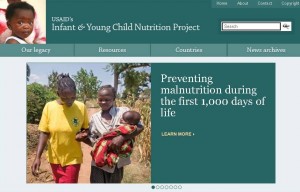 IYCN recently launched an enhanced website to offer improved access to our project accomplishments and lessons learned, in addition to hundreds of resources. The website offers up-to-date information on the 16 countries where we worked, an improved resources database, and a collection of IYCN’s publication series (see links on the right). We will post final summaries of our legacy and accomplishments soon. Although it will no longer be updated after March 2012, the website will remain available for several years.
IYCN recently launched an enhanced website to offer improved access to our project accomplishments and lessons learned, in addition to hundreds of resources. The website offers up-to-date information on the 16 countries where we worked, an improved resources database, and a collection of IYCN’s publication series (see links on the right). We will post final summaries of our legacy and accomplishments soon. Although it will no longer be updated after March 2012, the website will remain available for several years.
Please visit iycn.org.
Series of events to mark progress and look ahead
Over the past year, IYCN has hosted more than a dozen events—including a series of meetings in Washington, DC, and end-of-project gatherings in seven countries—to celebrate accomplishments, share experiences and resources, and discuss future directions for nutrition programming.
View highlights from our 2011 event series.
Documenting our experiences
We are pleased to share several new reports as part of our collection of country briefs launched last year. The collection offers a summary of IYCN’s experiences and accomplishments in each country where we worked.
View all country briefs.
Sharing our approaches
We have also completed our series of four brief documents examining our approaches in selected countries. New publications include:
- Mobilizing social workers to prevent malnutrition in Côte d’Ivoire.
- Promoting breastfeeding as an option for HIV-positive mothers in Haiti.
View the series.
Featured resource: Review of breastfeeding literature
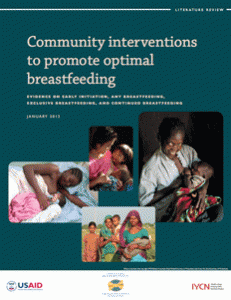 Our latest literature review examines evidence on community interventions to promote optimal breastfeeding. We are grateful to our colleague Dr. Miriam Labbok, Director of the Carolina Global Breastfeeding Institute at the University of North Carolina at Chapel Hill, for expertly composing this publication. Dr. Labbok shared her thoughts on the findings of the review in a recent Q&A.
Our latest literature review examines evidence on community interventions to promote optimal breastfeeding. We are grateful to our colleague Dr. Miriam Labbok, Director of the Carolina Global Breastfeeding Institute at the University of North Carolina at Chapel Hill, for expertly composing this publication. Dr. Labbok shared her thoughts on the findings of the review in a recent Q&A.
See the Q&A with Dr. Labbok.
Download Community interventions to promote optimal breastfeeding: Evidence on early initiation, any breastfeeding, exclusive breastfeeding, and continued breastfeeding.
More new IYCN resources
Global
Côte d’Ivoire
Ethiopia reports
Ethiopia training materials and tools
Ghana
Haiti
Kenya
Madagascar
Malawi
Photos: PATH/Mike Wang; PATH/Evelyn Hockstein; PATH/Evelyn Hockstein
 We hosted more than a dozen events in 2011—including a series of meetings in Washington, DC, and end-of-project gatherings in seven countries—to celebrate accomplishments, share experiences and resources, and discuss future directions for nutrition programming. We are grateful to the more than 1,000 partners and colleagues who joined us at these events—contributing valuable insights during lively discussions about practical solutions for reaching mothers and children with nutrition interventions. Discussions resulted in many partners pledging to carry forward with IYCN’s work and to continue building on momentum to address maternal and child malnutrition.
We hosted more than a dozen events in 2011—including a series of meetings in Washington, DC, and end-of-project gatherings in seven countries—to celebrate accomplishments, share experiences and resources, and discuss future directions for nutrition programming. We are grateful to the more than 1,000 partners and colleagues who joined us at these events—contributing valuable insights during lively discussions about practical solutions for reaching mothers and children with nutrition interventions. Discussions resulted in many partners pledging to carry forward with IYCN’s work and to continue building on momentum to address maternal and child malnutrition.
Highlights include:
- Malawi, December 2011. Panelists concluded that putting a new cadre of community nutrition workers in place across the country will help to prioritize nutrition in communities and reduce the workload of existing community-based workers. They also discussed how to overcome challenges in reaching the government’s goal to implement the new cadre. Following the event, panelist Dr. Mary Shawa, the Principal Secretary for Nutrition and HIV/AIDS at the Ministry of Health, highlighted key points from the discussion during a nationally televised interview.
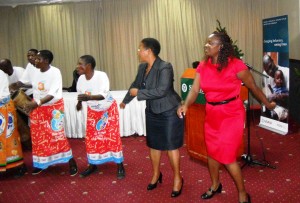
Malawi, December 2011
- Haiti, December 2011. In her opening remarks, Dr Jacqueline Gauthier, President of the Haitian Pediatric Society, emphasized that national guidelines for promoting exclusive breastfeeding—developed by the IYCN Project—were a crucial tool for convincing pediatricians and other stakeholders about the importance of exclusive breastfeeding, including within the context of HIV.
- Ethiopia, December 2011. Addressing participants, Sheri-Nouane Duncan-Jones, the head of HIV/AIDS programming for the US Agency for International Development office in Ethiopia, said that “as we work towards the goal of achieving an AIDS-free generation, we must remember that nutrition and feeding are unquestionably linked to HIV/AIDS programs.” Read a summary of the event on Nazret.com, a national blog: U.S. Focuses on Improving Infant and Young Child Nutrition in Ethiopia.
- Ghana, December 2011. Wilhelmina Okwabi, the Deputy Director in Charge of Nutrition, led a discussion on continuing momentum to improve complementary feeding practices. She urged Brong Ahafo Region to roll out a social marketing intervention developed by IYCN, the Global Alliance for Improved Nutrition, PATH, and the Ghana Health Service to an additional 13 districts, and encouraged district health officials to create a timeline for training health workers to strengthen infant and young child feeding counseling skills in 2012.
- Nigeria, October 2011. Governmental and nongovernmental partners committed to work together to fund and continue implementing the project’s nutrition training efforts for health workers and community workers in 28 states and to print counseling job aids for all training participants.
- Washington, DC, August 2011. Following a presentation of IYCN’s preliminary results from a review on the relationship between maternal and child diets, the Food and Agriculture Organization of the United Nations invited us to share the final results with international nutrition stakeholders during a symposium in Rome in January 2012.
- Washington, DC, August 2011. After the launch of our tools for agriculture project designers, India’s National Rural Livelihoods Mission and Nigeria’s National Programme for Food Security began adapting the tools for national use.

Washington, DC, July 2011
- Washington, DC, July 2011. Since launching our collection of materials for strengthening community nutrition programming, we have distributed more than 5,500 copies of the materials to stakeholders around the world and many colleagues have planned to adapt the tools for use in their programs.
- Zambia, March 2011. Following discussions about community interventions at an event with 100 key stakeholders, the United Nations Children’s Fund printed and disseminated more than 60,000 copies of community training materials, developed by the project and partners, to community health volunteers across the country.
Photos: PATH/Evelyn Hockstein, Valerie Kushata
 Dr. Miriam Labbok, Director of the Carolina Global Breastfeeding Institute at the University of North Carolina at Chapel Hill, and author of the Infant & Young Child Nutrition Project’s latest review of breastfeeding literature, reflects on her findings.
Dr. Miriam Labbok, Director of the Carolina Global Breastfeeding Institute at the University of North Carolina at Chapel Hill, and author of the Infant & Young Child Nutrition Project’s latest review of breastfeeding literature, reflects on her findings.
Download Community interventions to promote optimal breastfeeding: Evidence on early initiation, any breastfeeding, exclusive breastfeeding, and continued breastfeeding.
Why was this literature review needed?
We found that there had not been a review of the literature examining community interventions to promote optimal breastfeeding in more than a decade, and we wanted to compile the evidence since then to inform nutrition programs and policies. There have been several reviews of breastfeeding programs, child health programming in communities, and nutrition in communities, and we were able to re-analyze some of these new data to better understand the impact of breastfeeding support in the community.
Was there anything that surprised you during the review?
One surprise was the limited comparability across the interventions described in the literature. The interventions were carried out, as expected, in a wide variety of settings, but they rarely used the same cadre of workers, the same linkages to (or non-linkages to) local health systems, the same training, the same trainers, the same purposes (e.g., initiation versus exclusive versus duration). Those interventions that were most comparable were generally carried out by the same organization, but not for the purpose of testing differences. The reality is that resources are limited for breastfeeding interventions and perhaps we must learn from whatever is available until there are large-scale, comparable efforts to study this issue.
What did you find most interesting?
This analysis confirmed previous findings, that community efforts can have a substantial impact on breastfeeding practices. It was not clear from this review whether or not community efforts would lead to permanent changes in breastfeeding patterns; however, this analysis confirmed previous speculation regarding the presence of a supportive health system synergized with community efforts: those community interventions that were linked to positive health systems with breastfeeding support already in place appeared to have a greater impact on breastfeeding. This may be due to the fact that a supportive health system supplies an impetus for sustaining the gains, but also may be due to the fact that a supportive health system will not undercut the impact of the community effort by sending mixed messages. This finding underscoring the need for a comprehensive approach is supportive of the approach called for by the World Health Organization and the United Nations Children’s Fund in the Global Strategy for Infant and Young Child Feeding, and by the United States Agency for International Development in its breastfeeding policy. Both policies call for comprehensive intervention approaches, which include the government, health systems, workplaces, and communities in protecting, promoting, and supporting women to choose and succeed in optimal breastfeeding.
Based on this review, what are the top two or three recommendations you would make to program managers?
The strongest messages from this review are (1) the importance of choosing the appropriate worker and providing the appropriate training specifically designed for the needs of the particular setting and the purpose of the program, whether it be initiation, exclusivity, duration, or all; and (2) the increased impact achieved when the community program is complemented by the existence of breastfeeding-supportive practices in the health system or other successful efforts in nutrition, maternal health, or other complementary programs in the community. The third message is that the need for community interventions is great and the time to act is now.
Hadiya1 spoons warm porridge into six-month-old Aminah’s2 mouth and finds that on the first try, Aminah gobbles it up. Hadiya has learned the importance of introducing her daughter to porridge at six months, using nutrient-rich foods like soy flour, powdered milk, egg yolk, and peanut paste. She’s been coming to the Port Bouët II social center each week for several months—though she was forced to flee to her aunt’s village for a time, when the soldiers took over the center during the civil crisis. Côte d’Ivoire has endured a challenging past, with several civil wars and the more recent civil crisis following the disputed presidential election in November 2010 that caused widespread casualties, uprooted populations, and put a halt to development programs like the US Agency for International Development’s Infant & Young Child Nutrition (IYCN) Project.
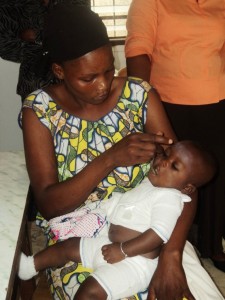
Hadiya feeds her six-month-old daughter enriched porridge that she learned to make during a cooking demonstration at the Port Bouët II social center.
Since 2007, the IYCN Project has been working to prevent malnutrition of mothers and children younger than two years and to maximize HIV-free survival among children born to HIV-positive mothers. One of the project’s primary approaches to preventing malnutrition is reaching orphans and vulnerable children through government-supported social centers. IYCN works with national-level programs to train social workers in more than 30 centers throughout the country to monitor children’s growth and counsel caregivers on optimal infant and young child feeding practices, particularly within the context of HIV. In addition to counseling materials, the project supplies the centers with anthropometric equipment and cooking materials. At the heart of the community, social workers support community health workers to identify children with the highest risk of mortality—those who are severely acutely malnourished. The community health workers conduct home visits to see how caregivers are preparing enriched porridge for their moderately malnourished children, and encourage households to bring their children for monthly growth monitoring and promotion sessions at the social centers.
Hadiya explains how she likes to come to the social center to receive care that she knows is good for her child.
“I come here every week. This is my first child in ten years, and I want to protect her and keep her healthy,” she said.
Hadiya attends weekly cooking demonstrations to learn about new ways to prepare enriched porridge using locally available foods that she can afford. She explains that she will continue to breastfeed throughout the night and day and offer porridge in the morning and evening. Several mothers explain that before they started coming to the social center, they gave their children water because they thought they were thirsty. In talking with social workers, they learned that giving only breastmilk frequently was the perfect nourishment for their children until six months of age.
Having scales, height boards, and mid-upper arm circumference tapes has helped the social workers to better monitor children’s growth over time and to identify when a child has faltering growth or is already malnourished.
“[Before receiving equipment], we would look at physical characteristics, like edema and loose skin, to decide if a child was suffering from [severe] malnutrition,” remarked one social worker.
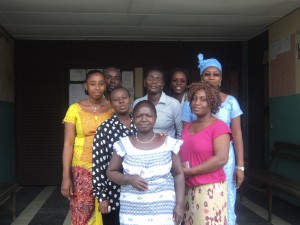
Social workers at the Koumassi social center.
Another social worker explains that now during counseling sessions, she starts by looking at the child’s weight over time on the growth chart to determine if the child is growing well.
“When we see weights going up and down over time, we know there is something wrong. I ask what is going on: is your child sick, how do you feed, what do you feed?” she said.
She asks the caregiver about feeding practices: whether the child younger than six months is being exclusively breastfed; about breastfeeding positions; and when the child is older than six months, whether the child is given thin porridge made of cereal flour and water.
“I explain that giving this thin porridge will only make them sicker. Depending on the mother’s responses, I advise her,” the social worker explained.
After being trained on counseling caregivers about optimal feeding practices, the social workers feel more confident in their services.
“The training we received was very practical in that we learned to identify when a child wasn’t growing well and what to do about it. We learned about vitamins and what micronutrient deficiencies children are at risk of. I [now] counsel moms on choosing the salt with iodine in it, to keep oranges in the shade so the sun won’t destroy the vitamin C, and that palm oil is rich in vitamin A. We also learned to make thicker and enriched porridge by adding powdered milk or soy flour,” explained one social worker.
Another shares that “before [the training], we didn’t know we were making thin porridge and advised moms to start [breastfeeding] at four months.”
Now that the neighborhood is safe and the social center is running again, Hadiya says that she will continue to come to the social center to hear the various talks on family planning and nutrition, have her child weighed and immunized, and attend cooking demonstrations now that she has introduced solid food.
1The interviewee’s real name has not been used for protective purposes.
2The interviewee’s real name has not been used for protective purposes.
Photos: PATH/Jennifer Burns
Welcome to the tenth issue of the IYCN Update, a newsletter from USAID’s Infant & Young Child Nutrition (IYCN) Project. Distributed four times per year, each issue offers updates on the latest research, new resources, and project news.
Research highlights
Peer counseling increases exclusive breastfeeding rates
Results of the PROMISE-EBF study, a cluster-randomized trial published in The Lancet in July 2011, showed that a low-intensity peer counseling intervention may have the potential to increase exclusive breastfeeding in sub-Saharan Africa for infants up to 6 months of age. Read more.
Effects of vitamin A or beta carotene supplements on maternal and infant mortality
A randomized controlled trial, published in the May 2011 edition of the Journal of the American Medical Association, examined the impacts of weekly vitamin A or beta carotene on maternal and infant mortality in Bangladesh. Researchers found no significant differences in all-cause maternal, fetal, or infant mortality in the vitamin A group or the beta carotene group as compared to the control. While the findings differ dramatically from a similar study in Nepal, a recent large-scale trial in Africa showed similar results. Read more.
Balanced protein energy supplementation beneficial during pregnancy
In a meta-analysis published in Biomed Central Public Health in April 2011, researchers found a 31 percent reduction in the risk of delivering a baby who was small for gestational age when mothers were provided with a balanced protein energy supplementation during pregnancy. The authors conducted the review in order to recommend a point estimate for the intervention’s inclusion in the Lives Saved Tool. Read more.
Human nutrition as a benefit of agricultural ecosystems
The authors of a paper published in a supplement to the Food and Nutrition Bulletin in March 2011 make a case for treating agriculture as an ecological system serving human nutrition. They suggest that ecological knowledge, tools, and models have an important role to play in efforts to direct food systems at improved human nutrition. Read more.
Featured resource: Strengthening community nutrition programming
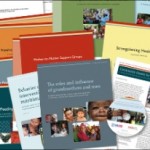
In July, we launched our new collection of tools for reaching caregivers, households, and communities. The collection includes literature reviews, training materials, and monitoring and evaluation tools that program implementers can adapt and use to enhance community nutrition programs. IYCN has employed the resources in several countries to reach mothers and engage key influencers, such as fathers, grandmothers, and community leaders, to improve nutrition during the first 1,000 days of life. Learn more and download the resources.
Country spotlight: Nigeria
Building a strong foundation for nutrition programming
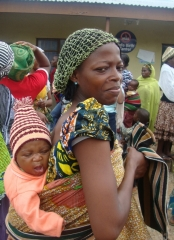 Since 2009, IYCN has supported the government of Nigeria’s efforts to reduce maternal and child malnutrition and improve HIV-free survival of children. In collaboration with a wide range of partners, IYCN’s efforts have increased understanding of gaps in nutrition assessment, counseling, and support; influenced and strengthened five national nutrition policies and guidelines; and improved the capacity of health workers and community workers.
Since 2009, IYCN has supported the government of Nigeria’s efforts to reduce maternal and child malnutrition and improve HIV-free survival of children. In collaboration with a wide range of partners, IYCN’s efforts have increased understanding of gaps in nutrition assessment, counseling, and support; influenced and strengthened five national nutrition policies and guidelines; and improved the capacity of health workers and community workers.
The project also developed several new social and behavior change communication tools for health providers and caregivers and strengthened nutrition services through a quality improvement approach.
At an October 27 end-of-project event, partners committed to scaling up capacity building activities to 28 states.
View a summary of our activities and accomplishments in Nigeria.
View a summary of our approach to shaping infant feeding and HIV policy in Nigeria.
Project news
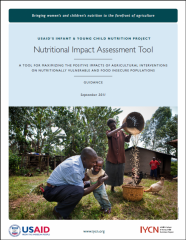 New and improved tools for agriculture project designers
New and improved tools for agriculture project designers
After making several improvements and revisions, IYCN recently launched new versions of two tools to help agriculture projects maximize nutritional benefits of interventions. The project shared the new resources with more than 70 participants during a September 7 forum in Washington, DC, and presented them to a crowd of more than 300 colleagues at the Federation of African Nutrition Societies Congress in Abuja, Nigeria on September 14. View the new tools.
Read an IRIN news article on IYCN’s Nutritional Impact Assessment Tool.
Supporting SUN, ending stunting in Malawi
The IYCN team recently joined with the Office of the President and Cabinet and a wide range of partners to support the Scaling Up Nutrition (SUN) movement in Malawi, one of the first countries to launch the movement.
To build broad support for the country’s new SUN strategy and ensure its success, the project has encouraged civil society participation, developed a new package of training materials for community workers, led a working group on monitoring and evaluation to develop indicators for the SUN strategy, and participated in a high-level SUN event during the UN General Assembly in New York in September 2011.
Read IYCN Malawi Country Coordinator Janet Guta’s post on the 1,000 Days blog to learn more.
Events
Bringing nutrition to the forefront of agriculture: a forum for agriculture project designers
On September 7, more than 70 colleagues joined IYCN and the Alliance to End Hunger to discuss the linkages between agriculture and nutrition programming. The half-day event featured a forum on the integration of nutritional concerns into agricultural programming, and a practicum on the assessment and improvement of agricultural project designs to maximize nutrition and food security outcomes. Learn more.
Preventing maternal malnutrition: evidence, challenges, and opportunities
IYCN hosted a panel discussion on preventing maternal malnutrition on August 16. Panelists shared findings from three IYCN studies revealing insights on dietary practices of mothers; discussed the links between maternal and child nutrition; and explored barriers, challenges, and solutions for programs to prevent malnutrition of mothers. Learn more.
Brown bag: Engaging grandmothers and men to prevent malnutrition
On August 10, IYCN hosted a brown bag presentation and discussion with Dr. Judi Aubel of The Grandmother Project. Dr. Aubel shared findings from IYCN’s review of literature from more than 40 countries on the roles and influence of grandmothers and men and discussed recommendations for effectively engaging key household members to improve nutrition. Learn more.
What works for community nutrition programming?
 More than 150 participants joined IYCN on July 19 for a half-day meeting on community programming to prevent malnutrition. Speakers included IYCN country coordinators from five countries and the project’s partners, who shared challenges, experiences, and future directions for community nutrition interventions during a lively discussion moderated by Denise Lionetti, IYCN Project Director. Learn more.
More than 150 participants joined IYCN on July 19 for a half-day meeting on community programming to prevent malnutrition. Speakers included IYCN country coordinators from five countries and the project’s partners, who shared challenges, experiences, and future directions for community nutrition interventions during a lively discussion moderated by Denise Lionetti, IYCN Project Director. Learn more.
Additional IYCN materials
Technical briefs
Tools and guides
For agriculture project designers
We welcome your feedback and suggestions for our next issue. Please contact: info@iycn.org.
Photos: Aurelio Ayala III, Evelyn Hockstein, Oluseyi Akintola, Jay Ward
May 2011
In an effort to extend the findings of a study in Nepal that reported a 44 percent decrease in maternal mortality resulting from vitamin A or beta carotene supplementation in pregnancy, researchers conducted a large randomized controlled trial in Bangladesh, providing the same dosages that were used in the Nepal study. Supplements were provided from the identification of pregnancy through 12 weeks postpartum. In the study in Bangladesh, however, no differences from control were observed for all-cause maternal, fetal, or infant mortality. While these results differ dramatically from the Nepal study, they concur with those from a similar large-scale trial in Ghana, which also showed no mortality reduction from weekly vitamin A or beta carotene supplementation. The authors suggest a variety of factors that may account for the discrepancy between the Nepal and Bangladesh results, including a lower prevalence of vitamin A deficiency, higher proportion of attended births, and much lower mortality among mothers in Bangladesh.
Effects of Vitamin A or Beta Carotene Supplementation on Pregnancy-Related Mortality and Infant Mortality in Rural Bangladesh: A Cluster Randomized Trial
March 2011
The authors of a paper published in a supplement to the Food and Nutrition Bulletinin March 2011 make a case for approaching agriculture as an ecological system serving human nutrition. They argue that the same factors that enhance a farm’s ecological performance can enhance the nutritional value it produces.
Greater species diversity enhances the performance of ecological systems, the authors claim, for two reasons: as the richness of species diversity increases, the likelihood increases that at least one of the species will survive a change in the environment, and diverse species interact to facilitate each other’s success. Applying these principles to agriculture and nutrition, they introduce the concept of “functional biodiversity,” where “function” refers to the nutrients the species provides to humans, and suggests that richer functional biodiversity improves both the nutritional and ecological performance of a farm system.
To illustrate their point, they contrast two farms, each growing five species: one with functionally diverse species (maize, beans, squash, sweet potato, and guava), and one with functionally similar species (maize, rice, wheat, sorghum, and millet). Simple species biodiversity is the same for both farms (five species), but the functionally biodiverse system would supply a more diverse diet, providing a greater variety of nutrients. The functionally biodiverse system would perform better ecologically as well, since the mix of functionally dissimilar crops is more likely to have at least one survivor if growing conditions change, and because the crops facilitate each other’s success (e.g., beans fix nitrogen in the soil, benefiting the maize).
To test their concept, the authors compared hemoglobin levels in a Kenyan village based on the level of functional species biodiversity and simple species biodiversity on an individual’s farm. They found that higher functional biodiversity was associated with higher hemoglobin concentration, but detected no relationship with simple species diversity. They suggest that ecological knowledge, tools, and models have an important role to play in efforts to direct food systems at improved human nutrition.
Ecological approaches to human nutrition
July 2011
Results of a community-based cluster-randomized trial, published in The Lancet in July 2011, demonstrated the impact of peer counseling and support on exclusive breastfeeding (EBF) and diarrhea prevalence in Burkina Faso, Uganda, and South Africa. Peer counselors provided information and home-based support and encouragement for six months of EBF. Mothers participating in the study were offered at least five visits, including one antenatal visit. Comparisons between groups showed higher EBF prevalence at 12 and 24 weeks (assessed by both 24-hour and 7-day recall) among mothers who received peer support in all countries. EBF prevalence was lower at 24 weeks than at 12 weeks in both groups, but the difference between groups was greater at the later assessment.
Although EBF prevalence among mothers receiving peer counseling in Burkina Faso and Uganda was 50 percent or higher at both assessments (7-day recall), in South Africa, prevalence reached only 8 percent at 12 weeks and fell to 2 percent at 24 weeks. The authors attribute this to mixed messages received by South African mothers resulting from promotion of infant formula under the Department of Health’s protein energy malnutrition scheme, previous provision of infant formula by the National Programme for Prevention of Mother-to-Child Transmission of HIV-1, and uncontrolled marketing of infant formula due to the lack of legislation enforcing the International Code of Marketing of Breast-milk Substitutes.
No differences due to the intervention were noted for the prevalence of diarrhea at age 12 weeks or 24 weeks. Since this finding contradicts the results of some similar studies, the authors speculate that breastfeeding may have less effect on diarrhea incidence than on its duration and severity, which were not measured in this study. They also note that in communities where predominant breastfeeding is common, such as Burkina Faso and Uganda, a shift to EBF may not result in large changes in diarrhea-associated morbidity.
The study demonstrates that fairly low-intensity peer counseling intervention may have the potential to significantly increase EBF in sub-Saharan Africa for infants aged up to 6 months.
Exclusive breastfeeding promotion by peer counsellors in sub-Saharan Africa (PROMISE-EBF): a cluster-randomised trial
 Dear colleagues,
Dear colleagues,